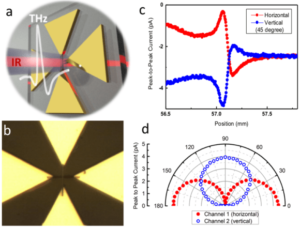Seminar Summary: Nanowire-based devices for THz polarimetry
07 Feb, 2022
Over the past few decades THz time domain spectroscopy (THz-TDS) has revolutionized spectroscopy and imaging in this rich region of the electromagnetic spectrum.[1] THz-TDS directly measures electric field as a function of time, making it excellent for probing the dielectric properties of materials.[1] The pulsed nature of the technique has allowed it to be extended to study dynamic process with femtosecond time resolution.[2] To date most THz-TDS spectrometers and imagers just generate and measure linearly polarized THz radiation.
However, the polarization state of a THz pulse can contain as much information as in the amplitude and phase spectra.[3,4] We have exploited the unique interactions of semiconductor nanowires to optical and THz photons [4] to designed and realize a compact THz detector that measures the complete state of a THz pulse.[5] The detector consists of two orthogonal bow-tie antennas fabricated on an insulating quartz substrate.
Each antenna pair is connected by InP nanowires in such a way that the orthogonal antennas are electrically insulated from each other. The polarization selectivity of the nanowires to a gating laser pulse combined with minimal shadowing makes nanowires the ideal photoconductive element in this detector. Using this detector, we have performed THz polarimetry on THz meta-materials and characterized anisotropic media [5].
The design of our detector eliminates cross-talk between polarization channels and the resulting device also very compact and alignment insensitive. Thus, the cross-nanowire detector can easily replace a standard photoconductive emitter in most THz-TDS systems without significant alteration to the spectrometer or imaging system.
[1] SS Dhillon et al. The 2017 terahertz science and technology roadmap.
J. Phys. D-Appl. Phys., 50:043001 (2017)
[2] CQ Xia, S Ponce, JL Peng, AM Ulatowski, JB Patel, AD Wright, RL Milot, H Kraus, QQ Lin, LM Herz, F Giustino, MB Johnston. Ultrafast photo-induced phonon hardening due to pauli blocking in MAPbI3 single-crystal and polycrystalline perovskites. J. Phys-Mater., 4:044017 (2021)
[3] CQ Xia, M Monti, JL Boland, LM Herz, J Lloyd-Hughes, MR Filip, MB Johnston. Hot electron cooling in InSb probed by ultrafast time-resolved terahertz cyclotron resonance
Phys. Rev. B, 103:245205 (2021)
[4] K Peng, MB Johnston, The application of one-dimensional nanostructures in terahertz frequency devices. Appl. Phys. Rev., 8:041314 (2021) [5] K Peng, D Jevtics, F Zhang, S Sterzl, DA Damry, MU Rothmann, B Guilhabert, MJ Strain, HH Tan, LM Herz, L Fu, MD Dawson, A Hurtado, C Jagadish, MB Johnston. Three-dimensional cross-nanowire networks recover full terahertz state. Science, 368:510–513 (2020)

Michael Johnston is Professor of Physics at the University of Oxford, where he leads a research group working on terahertz photonics and semiconductor devices, and Honorary Professor at the Australian National University. His PhD work at the University of New South Wales (Australia) focused on Quantum Well Infrared Photodetectors. In 1999 Michael moved to the Cavendish Laboratory as a postdoctoral researcher, and in 2002 he was appointed to a faculty position in the Department of Physics at the University of Oxford. His current research interests include terahertz spectroscopy of nanowires; the development of THz photonic devices and the vapour deposition of perovskite semiconductors for device applications.